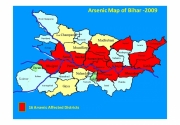 This presentation deals with the problem of arsenic contaminated aquifers in the Gangetic belt of Bihar and the failure of the state government in tackling the crisis and calls for the establishment of a centralized knowledge & research hub with an understanding of the regional peculiarities to mitigate the crisis.
This presentation deals with the problem of arsenic contaminated aquifers in the Gangetic belt of Bihar and the failure of the state government in tackling the crisis and calls for the establishment of a centralized knowledge & research hub with an understanding of the regional peculiarities to mitigate the crisis.
It traces the origin of arsenic crisis to the switch from use of surface water to groundwater. The health impacts of arsenic poisoning and the factors that aggravate arsenicosis are explained. A total of sixteen districts (fifty-seven blocks) in Bihar are affected by high levels of arsenic in groundwater, in trivalent form, which is a more toxic form of arsenic.
The major problems of arsenicosis management in Bihar are discussed and some techno-economically viable options for arsenic mitigation are prescribed:
- Gravity driven filters: Low cost, easy to maintain and operate, not dependent on electricity and allows quick disposal of backwash and sludge through bioremediation.
- Traditional wells with proper sanitization, such as those under the Project Well initiative.
- In-situ arsenic treatment, using TIPOT technology of Queens University Belfast, based on the principle of adsorption.
- Reverse Osmosis/ Nano membrane system attached with solar power.
As regards technology of arsenic removal, it is vital that it comprises technology for sludge disposal as well.
The need for research on hydro‐geological aspects of arsenic contaminated aquifers is stressed to capture the pecularities of Bihar, which is generally ignored as most of the investigations have been centered on West Bengal up till now. The need to upgrade the knowledge and medical infrastructure related to diagnosis and treatment of arsenicosis is highlighted. A comprehensive database on arsenic contaminated aquifers is a prerequisite, as is the need to build community participation for maintaining and monitoring the mitigation programmes.
Download the presentation:
/articles/arsenic-contamination-groundwater-bihar-and-mitigation-strategies-research-study